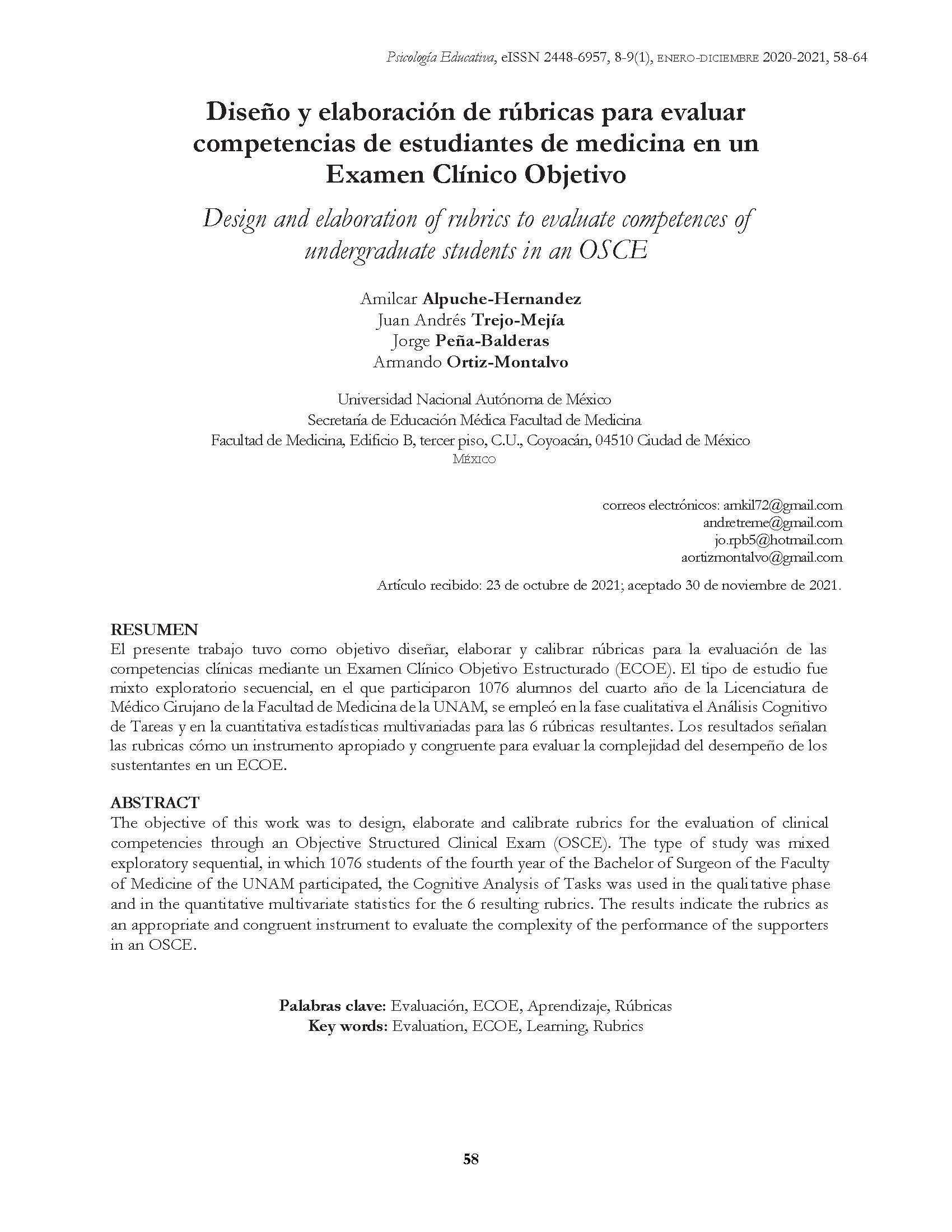Abstract
The objective of this work was to design, elaborate and calibrate rubrics for the evaluation of clinical competencies through an Objective Structured Clinical Exam (OSCE). The type of study was mixed exploratory sequential, in which 1076 students of the fourth year of the Bachelor of Surgeon of the Faculty of Medicine of the UNAM participated, the Cognitive Analysis of Tasks was used in the qualitative phase and in the quantitative multivariate statistics for the 6 resulting rubrics. The results indicate the rubrics as an appropriate and congruent instrument to evaluate the complexity of the performance of the supporters in an OSCE.
References
Almalki S. (2016). Integrating quantitative and Qualitative data in mixed methods research – Challenges and benefits. Journal of education and learning, 5 (3):288-96.
Andrew S, Halcomb E.J, Kroll T & Neri M. (2009). Designs for mixed methods research. Mixed methods research for nursing and the health sciences. Oxford: Wiley-Blackwell. (pp. 31-49).
Bloom, B. y Krathwohl D. (2012). Major categories in the taxonomy of educational objectives .[citado: 10 de mayo de 2012], de [internet] Sitio web: : http://krummefamily.org/guides/bloom.html. 7.
Brookhart S. (2013). How to create and use rubrics for formative assessment and grading.Alexandria Virginia: ASCD.
Castañeda, S. (2006). Evaluación del aprendizaje en el nivel universitario: elaboración de exámenes y reactivos objetivos. Evaluación del aprendizaje en educación superior. México: UNAM. (pp. 3-27).
Cassese T, Ceccolini, B, Rockfeld F & Rosenberg I. (2017). Medical students review of formative OSCE scores, checklists, and videos improves with student-faculty debriefing meetings. MEDICAL EDUCATION ONLINE, VOL 22, 1324718.
Cleave H.D, Guest CB, y Morgan PJ. (2001). A comparison of global ratings and checklist scores from an undergraduate assessment using an anesthesia simulator. Acad Med .76:1053–1055
Creswell JW.(2014). Research Design: Qualitative, Quantitative and Mixed Methods Approaches (4th ed.). Thousand Oaks, CA: Sage.
Dankoski ME y Turner JL. (2008). Objective Structured Clinical Exams: A Critical Review.Fam Med 40:574–578.
Downie W, Harden R, Stevenson M &Wilson G. (1975). Assessment of clinical competence using objective structured examination. cited 2016 Sep 20, de 1(5955):447–51 Sitio web: http://www.ncbi.nlm.nih.gov/pubmed/1115966
Egan T, Frampton CM, Thompson F.M. & Wilkinson TJ. (2003). Objectivity in Objective Structured Clinical Examinations: Checklists Are No Substitute for Examiner Commitment. Acad Med.78:219–223.
Furman G, Grimaldo J, Martínez A, Martínez I, Olivares S, Sánchez M & Trejo J. (2016). Validez de la Guía Sintética del Evaluador para un ECOE en tres instituciones de educación médica. Cancún, México: Congreso Internacional de Educación Médica.
Hamui A. (2013). Un acercamiento a los métodos mixtos de investigación en educación médica. Investigación en Educación Médica. (pp.211-16.)
Hodges B, y Mcilroy JH.(2003). Analytic global OSCE ratings are sensitive to level of training. Med Educ.37:1012–1016.
Miller G. (1990). The assesment of clinical skills/competence/performance. Acad Med. (pp. 63-7).
Plan de Estudios 2010 Licenciatura de Médico Cirujano. Facultad de Medicina UNAM

This work is licensed under a Creative Commons Attribution-NonCommercial-NoDerivatives 4.0 International License.
Copyright (c) 2024 Universidad Nacional Autónoma de México


